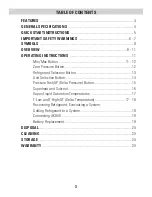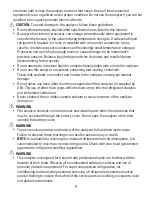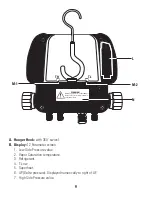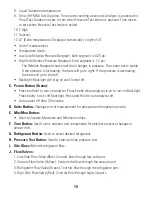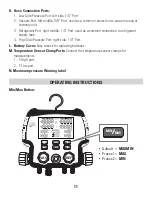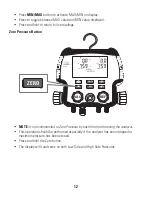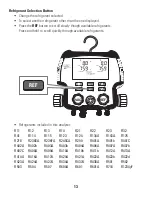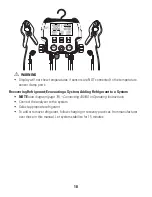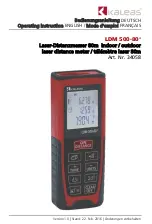
6
IMPORTANT SAFETY WARNINGS
WARNING
Read entire Safety Notes section regarding potential hazard and proper instructions before
using this meter. In this manual the word “
WARNING
” is used to indicate conditions or
actions that may pose physical hazards to the user. The word “
CAUTION
” is used to indicate
conditions or actions that may damage this instrument.
WARNING
•
WARNING:
DO NOT exceed Maximum
Pressure Range
: 725 psi
This analyzer’s specified maximum pressure range.
•
WARNING:
Proof Pressure
: 1000 psi
This is the pressure limit applied to the sensors without causing permanent damage.
Damage resulting from exceeding proof pressure level will void warranty and may cause
personal injury.
•
WARNING:
Burst Pressure
: 1500 psi
This is the maximum overload pressure at which the analyzer sustains permanent
damage, seal leakage or fails entirely. Damage resulting from exceeding burst pressure
level will void warranty and may cause personal injury.
• Do not use the analyzer if it operates abnormally. Protection may be impaired.
• Do not operate this analyzer or service batteries around explosive gas, vapor or dust.
• Various refrigerants have been intentionally excluded for very significant reasons.
Never use refrigerants in this analyzer that are not listed in the Refrigerant Selection
menu or Operating Instructions.
• The refrigerant database in this analyzer may include refrigerants classified as
flammable. If such refrigerants are selected, the operator may need additional
certifications and/or training. Consult with your local and state governments and fully
comply with all requirements.
• Always inspect the sample hoses before each use. Replace the hoses if they appear
cracked, frayed, obstructed or fouled with oil.
• Always wear eye and skin protection when working with refrigerants. Escaping
refrigerants will present a freezing danger. Do not direct refrigerants vapors venting
towards the skin.
• Do not breathe refrigerant and lubricant vapor or mist. Exposure may irritate eyes, nose
and throat. If accidental system discharge occurs, immediately ventilate work area.
• Because this analyzer allows for various inputs including electrical and mechanical,
care must be taken to observe any ways that a shock hazard could develop. Wet or
humid conditions, along with damaged temperature sensor clamp could allow an


